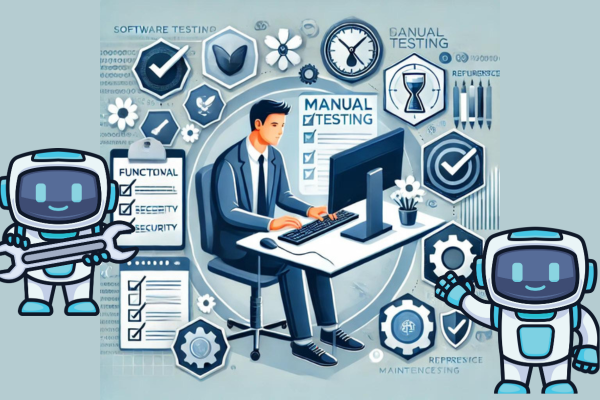Manual testing is an essential part of the software development process. This blog provides in-depth information on manual testing, covering everything from basics to advanced topics. Whether you’re a novice or a seasoned tester, this guide will help you navigate the complexities of manual testing.
Table of Contents
Introduction to Software Testing
Definition of software testing:
Software testing is evaluating a software application to identify defects, ensure quality, and verify that it meets specified requirements. Involves executing software/system components to verify that the software behaves as expected.
Importance of Testing in Software Development Lifecycle:
Manual Testing is important because it helps identify defects early, reduces the cost of fixing defects, and ensures that the software is reliable, secure, and works well. It is an integral part of the Software Development Life Cycle (SDLC), contributing to delivering high-quality products.
Overview of Testing Types: Manual vs. Automated Testing
- Manual Testing: Involves human testers to execute test cases without automation tools. It is ideal for exploration, usability and ad hoc testing.
- Automated Testing: Uses scripts and tools to execute test cases. It is suitable for iterative, high-volume and regression testing.
Understanding manual testing

What is manual testing?
Manual testing is the process of manually executing test cases to identify defects. Testers interact like end-users, verifying that the software works as expected. It is best suited for applications that require a human touch, such as complex UI/UX.
Advantages and Disadvantages of Manual Testing:
Advantages:
- Allows for human observation, intuition and user experience evaluation.
- Ideal for exploration and ad hoc testing.
- No programming knowledge is required.
Disadvantages:
- It is time-consuming and less efficient for large-scale testing.
- Prone to human error.
- Not suitable for repetitive tasks.
Roles and Responsibilities of Manual Tester:
- A manual tester is responsible for understanding the requirements.
- designing test cases, and executing them.
- reporting defects, and ensuring that the software meets the specified criteria.
- They collaborate closely with developers, product managers and other stakeholders.
Types of Manual Testing
Manual testing is a crucial process in software development that involves the manual execution of test cases without the use of automation tools. Here are the main types of manual testing along with examples for each:
1. Functional Testing
- Definition: Validates that the software functions as intended according to the specified requirements.
- Examples:
- Unit Testing: Testing the individual components or modules of a software application.
- Example: A tester verifies that a function in an e-commerce application correctly calculates the total price of items in a cart.
- Integration Testing: Testing the interaction between integrated units or components.
- Example: In a banking application, the integration between the login module and the transaction module is tested to ensure smooth interaction.
- System Testing: Testing the complete and integrated software system to evaluate its compliance with the specified requirements.
- Example: In a travel booking system, a tester checks the entire workflow, from searching for flights to making a payment.
- User Acceptance Testing (UAT): Validates the software against user requirements and ensures it meets business needs.
- Example: A client reviews a CRM application to ensure it meets their business process requirements before going live.
- Unit Testing: Testing the individual components or modules of a software application.
2. Non-Functional Testing
- Definition: Evaluate the non-functional aspects of a software application, such as performance, usability, reliability, etc.
- Examples:
- Performance Testing: Measures the speed, responsiveness, and stability of the software under various conditions.
- Example: A tester assesses how quickly a website loads when multiple users access it simultaneously.
- Usability Testing: Ensures that the software is easy to use and provides a good user experience.
- Example: A tester evaluates a mobile app to ensure that users can easily navigate the interface and complete tasks without confusion.
- Security Testing: Identifies vulnerabilities and ensures that the software is secure against unauthorized access.
- Example: In a banking application, a tester verifies that unauthorized users cannot access sensitive data.
- Compatibility Testing: Ensures that the software works correctly across different browsers, devices, and operating systems.
- Example: A web application is tested on Chrome, Firefox, and Safari to ensure consistent behaviour.
- Compliance Testing: Validates that the software meets regulatory requirements and industry standards.
- Example: An e-commerce application is tested to ensure it complies with PCI-DSS standards for handling credit card transactions.
- Performance Testing: Measures the speed, responsiveness, and stability of the software under various conditions.
3. Maintenance Testing
- Definition: Performed after a software product has been deployed to ensure it remains functional after updates or modifications.
- Examples:
- Regression Testing: Ensures that recent code changes have not adversely affected existing functionality.
- Example: After adding a new feature to a payroll system, a tester checks that existing payroll calculations still work correctly.
- Re-testing: Verifies that previously identified defects have been fixed.
- Example: A tester re-tests a bug in a mobile app’s payment module after it has been fixed to ensure the issue is resolved.
- Regression Testing: Ensures that recent code changes have not adversely affected existing functionality.
Conclusion:
Manual testing is essential for verifying software quality from multiple perspectives. By understanding and applying different types of manual testing, testers can ensure that the software meets functional and non-functional requirements, is user-friendly, and secure, and performs well across various environments.

